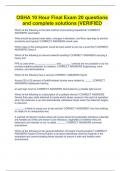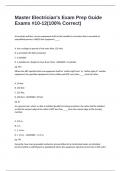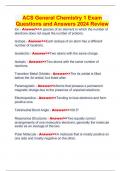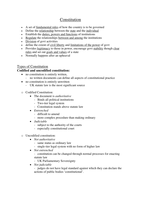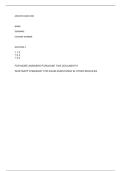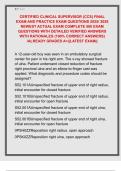Summary CAPI
Introduction
Easton’s political system: A country’s political system including institutions and agencies structures
the ways in which citizens’ preferences (inputs) are translated into policy (outputs). So on the one
hand you have the inputs of the citizens, existing of demands and supports, that go through the
political system and results in decisions and actions, named output. The output gets feedback by the
environment through a possible change of the inputs.
This model can help understand the relation between public administration and political science
because public policy can be seen as the output, thus public administration mainly focusses on this
part of Easton’s model. However, political science also focusses on the whole model of Easton
because it also needs input of the citizens to cover the part of the allocation and transfer of power in
decision making.
Ch.1: The Relevance of Comparative Politics
Comparative politics can be relevant for informing the public debate and giving advice to politicians
and government agencies about public policies. It also has a potential for serving more general goals
like increased social justice and improved human well-being.
The institutional turn: The shift from thinking that the well-being of a population depended on non-
political factors to seeing political institutions as the factors that make a change and can improve the
well-being of a population.
Representative democracy isn’t enough for creating human well-being. Without control of corruption
and increased administrative capacity, the well-being of citizens won’t improve.
Clark et al.
Plato believed that a state should be led by trained and informed specialists and not by the people
(democracy) because it would eventually lead to a tyrant ceasing power.
Aristotle believed that every good form of regimes that served the good for all could be corrupted
and then would be regimes that served the good of rulers (see table). One concern about democracy
was that it would lead to class warfare, since each class would rule to benefit themselves and not the
commonwealth.
A substantive view on democracy classifies political regimes in regard to the outcomes that they
produce and a minimalist/procedural view on democracy classifies political regimes in regard to their
institutions and procedures. Dahl believes that researchers should employ the minimalist view.
He has two dimensions to conceptualize democracy:
1. Contestation: the extent to which citizens are free to organize themselves into competing
blocs to press for politics and outcomes they desire (procedures of democratic competition)
2. Inclusion: who gets to participate in the democratic process
Three ways of operationalizing democracy and dictatorship:
1. The democracy-dictatorship measure
1
, Democracy is conceptualized as regimes in which governmental offices are filled as a
consequence of contested elections. A country is classified as a democracy when:
The chief executive is elected
The legislature is elected
There is more than 1 party competing in elections
An alternation in power under identical electoral rules has taken place
A country is a dictatorship if any of these don’t hold.
Similarities with Dahl: minimalist view
Difference: DD is dichotomous and Dahl uses a continuous scale, DD leaves out inclusion
2. Polity IV
A Polity score is constructed by the democracy score – the autocracy score and ranges form -
10 to + 10. The score is based on 5 dimensions:
Competitiveness of executive recruitment
Openness of executive recruitment
Constraints that exist on the executive
Regulation of political participation
Competitiveness of political participation
Similar to Dahl: minimalist view and continuous scale
3. Freedom House
The score is based on two dimensions: freedom in political rights and freedom in civil rights.
Similar to Dahl: Continuous scale
Differences: Substantive view
Validity: the extent to which our measures correspond to the concepts that they are intended to
reflect.
Reliability: the extent to which the measurement process repeatedly and consistently produces the
same score for a given.
Replicability: the ability for third-party scholars to reproduce the process through which a measure is
created.
Ch. 5; Democracies
Four general conditions for being a democracy:
1. Fair and free elections
2. Universal participation
3. Respect for civil liberties
4. Responsible government
The fact that all democracies share these four elements, doesn’t mean that all democracies look
alike. There is an important difference between parliamentary and presidential systems.
Characteristics parliamentary system:
1. Citizens vote to elect members of legislature and the majority in parliament determines who
becomes head of government
2. Prime minister and other ministers are member of parliament (in most cases)
3. There is a separation between the head of government and state. The principle of
responsible government implies that the elected prime minister commands the
administration; the political role of monarchs is weak.
4. Although parliamentary systems are mandated to call elections at certain intervals, an
election can take place sooner than expected if the prime minister clashes with the
parliament or vice versa.
2
, Characteristics presidential system:
1. Voters participate in separate electoral processes to elect members of the legislature and
head of government.
2. The president and the members of the cabinet aren’t members of congress, creating a strict
separation of powers.
3. The elected president is both head of government and head of state
4. Once the presidents and congressmembers are elected, they are expected to serve for a
fixed period until the end of their terms.
Semi-presidential regimes combine a directly elected president who serves in office for a fixed period
and a prime minister who’s responsible to parliament. It varies how much power is assigned to such
a president.
There are both advantages and disadvantages to the presidential system (see box 5.2).
Majoritarian Consensus
Electoral system Disproportional Proportional
representation
Party system Two-party Multi-party
Government Single-party Coalitions
Inter-branch balance Executive dominance Balanced power
Interest representation Pluralism Corporatism
Local government Unitary Federal
Legislature Unicameral Bicameral
Constitution Flexible Rigid
Judiciary Weak or no judicial Strong judicial review
review
Central bank Dependent on executive Independent
Optimal for Homogeneous societies Plural societies.
3
Introduction
Easton’s political system: A country’s political system including institutions and agencies structures
the ways in which citizens’ preferences (inputs) are translated into policy (outputs). So on the one
hand you have the inputs of the citizens, existing of demands and supports, that go through the
political system and results in decisions and actions, named output. The output gets feedback by the
environment through a possible change of the inputs.
This model can help understand the relation between public administration and political science
because public policy can be seen as the output, thus public administration mainly focusses on this
part of Easton’s model. However, political science also focusses on the whole model of Easton
because it also needs input of the citizens to cover the part of the allocation and transfer of power in
decision making.
Ch.1: The Relevance of Comparative Politics
Comparative politics can be relevant for informing the public debate and giving advice to politicians
and government agencies about public policies. It also has a potential for serving more general goals
like increased social justice and improved human well-being.
The institutional turn: The shift from thinking that the well-being of a population depended on non-
political factors to seeing political institutions as the factors that make a change and can improve the
well-being of a population.
Representative democracy isn’t enough for creating human well-being. Without control of corruption
and increased administrative capacity, the well-being of citizens won’t improve.
Clark et al.
Plato believed that a state should be led by trained and informed specialists and not by the people
(democracy) because it would eventually lead to a tyrant ceasing power.
Aristotle believed that every good form of regimes that served the good for all could be corrupted
and then would be regimes that served the good of rulers (see table). One concern about democracy
was that it would lead to class warfare, since each class would rule to benefit themselves and not the
commonwealth.
A substantive view on democracy classifies political regimes in regard to the outcomes that they
produce and a minimalist/procedural view on democracy classifies political regimes in regard to their
institutions and procedures. Dahl believes that researchers should employ the minimalist view.
He has two dimensions to conceptualize democracy:
1. Contestation: the extent to which citizens are free to organize themselves into competing
blocs to press for politics and outcomes they desire (procedures of democratic competition)
2. Inclusion: who gets to participate in the democratic process
Three ways of operationalizing democracy and dictatorship:
1. The democracy-dictatorship measure
1
, Democracy is conceptualized as regimes in which governmental offices are filled as a
consequence of contested elections. A country is classified as a democracy when:
The chief executive is elected
The legislature is elected
There is more than 1 party competing in elections
An alternation in power under identical electoral rules has taken place
A country is a dictatorship if any of these don’t hold.
Similarities with Dahl: minimalist view
Difference: DD is dichotomous and Dahl uses a continuous scale, DD leaves out inclusion
2. Polity IV
A Polity score is constructed by the democracy score – the autocracy score and ranges form -
10 to + 10. The score is based on 5 dimensions:
Competitiveness of executive recruitment
Openness of executive recruitment
Constraints that exist on the executive
Regulation of political participation
Competitiveness of political participation
Similar to Dahl: minimalist view and continuous scale
3. Freedom House
The score is based on two dimensions: freedom in political rights and freedom in civil rights.
Similar to Dahl: Continuous scale
Differences: Substantive view
Validity: the extent to which our measures correspond to the concepts that they are intended to
reflect.
Reliability: the extent to which the measurement process repeatedly and consistently produces the
same score for a given.
Replicability: the ability for third-party scholars to reproduce the process through which a measure is
created.
Ch. 5; Democracies
Four general conditions for being a democracy:
1. Fair and free elections
2. Universal participation
3. Respect for civil liberties
4. Responsible government
The fact that all democracies share these four elements, doesn’t mean that all democracies look
alike. There is an important difference between parliamentary and presidential systems.
Characteristics parliamentary system:
1. Citizens vote to elect members of legislature and the majority in parliament determines who
becomes head of government
2. Prime minister and other ministers are member of parliament (in most cases)
3. There is a separation between the head of government and state. The principle of
responsible government implies that the elected prime minister commands the
administration; the political role of monarchs is weak.
4. Although parliamentary systems are mandated to call elections at certain intervals, an
election can take place sooner than expected if the prime minister clashes with the
parliament or vice versa.
2
, Characteristics presidential system:
1. Voters participate in separate electoral processes to elect members of the legislature and
head of government.
2. The president and the members of the cabinet aren’t members of congress, creating a strict
separation of powers.
3. The elected president is both head of government and head of state
4. Once the presidents and congressmembers are elected, they are expected to serve for a
fixed period until the end of their terms.
Semi-presidential regimes combine a directly elected president who serves in office for a fixed period
and a prime minister who’s responsible to parliament. It varies how much power is assigned to such
a president.
There are both advantages and disadvantages to the presidential system (see box 5.2).
Majoritarian Consensus
Electoral system Disproportional Proportional
representation
Party system Two-party Multi-party
Government Single-party Coalitions
Inter-branch balance Executive dominance Balanced power
Interest representation Pluralism Corporatism
Local government Unitary Federal
Legislature Unicameral Bicameral
Constitution Flexible Rigid
Judiciary Weak or no judicial Strong judicial review
review
Central bank Dependent on executive Independent
Optimal for Homogeneous societies Plural societies.
3


